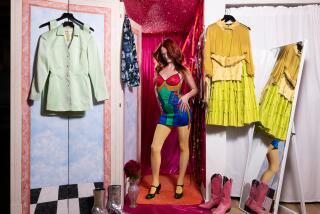Hangers Come Out of the Closet : Business Success Credited to Concern With Stores’ Looks
- Share via
Joan Crawford would approve. There are clothes hangers everywhere--wood hangers, metal hangers, plastic hangers--but none of the dreaded wire hangers the actress considered so declasse.
Hundreds of hangers line the walls and swing from floor racks inside the Henry Hanger Co. showroom--mauve hangers, burgundy hangers, marbled hangers and hangers of matte or ebony black. There are even high-tech hangers, checked hangers, and brass models priced at $150 each--hangers for every conceivable purpose, plus a mutant few with no discernible use.
And surveying it all is the king of the upscale hanger, the man who hitched his wagon to an ascending closet pole and hasn’t looked back, Bernie Spitz.
Business Is Better
“They say there’s no business like show business, but the hanger business is better,” said Spitz, a Howard Cosell sound-alike equally given to exaggeration. “It’s challenge; it’s excitement. And let me say this: If you can’t find it at Henry Hanger, you won’t find it anywhere.”
Spitz, 67, is a dapper dresser who wears an inch-long diamond-studded clothes hanger on his lapel. He claims to have 800 styles of hanger in his Hill Street showroom about two miles south of downtown Los Angeles. They’re made at the Los Angeles location and at a larger factory in New Hampshire. There is also a showroom in New York City, where Spitz’s father, Henry, started the business in 1933.
Is Bernie Spitz anything like Dave Whiteman, the hanger manufacturer portrayed by Richard Dreyfuss in “Down and Out in Beverly Hills”?
“Definitely,” said his daughter and executive secretary, Astrid Spitz-Metsos, 27. “The Dreyfuss character made wire hangers, which is a big difference. But they both have a love of the hanger business. And they’re both not the sort of people you meet every day.”
Principal Clients
Henry Hanger’s principal clients are clothing makers and retailers and the hotel industry, but the company also sells to the public.
“See,” Spitz said, leafing through a stack of paper work on his desk, “this is the sort of clientele we have.”
He pulled out an order from Marvin Davis, new owner of the Beverly Hills Hotel. Davis bought 10 dozen hangers for $267.50, or about $2.20 each. Is that, Spitz was asked, a lot for a hanger?
“Goodness no,” he said, rifling through the stack again. “Here we sold 23,000 hangers to the Esprit stores. The average manufacturer would do the job for $6,000 or $8,000. We did it for $86,000. But they got what they wanted--a high-class unbreakable hanger.”
Another order showed Victoria’s Secret, the lingerie chain, buying 9,000 hangers for $56,500, more than $6 each. The hangers are padded and made of hand-sewn silver-colored satin. Other clients include Perry Ellis, Galanos, Calvin Klein, Chloe, Nolan Miller and Somper furs.
Spitz, of Beverly Hills, said his company has seen lean times over the years but that sales recently have been strong. He declined to be more specific, saying: “We do a sizable business, but we’re privately owned and don’t give out that information. We’ll tell you how great we are, but not how much money we make.”
He credited the success, in part, to an increased attention by retailers to the appearance of their stores. They want “a look that sets them off from the competition,” he said.
Amy Valencia, public relations director of Esprit, agreed: “Esprit believes that no detail is small. Image is very important. Henry Hanger is who we’ve been dealing with ever since we opened because their hangers are smart looking. We had them designed to go with our store fixtures.”
The Esprit hanger comes in four styles, all made of flexible black plastic that is heat-stamped with the store’s logo and topped by a metal hook that swivels. At a cost of $3.73 each, the hangers are meant to stay inside the store.
“When we sell a product,” Valencia said, “we put it on a simple gray hanger if the person wants one. It’s a plain-wrap hanger.”
What Keeps Him Busy
Although hangers for men’s apparel make up part of Spitz’s business--the New York tailor Maurizio has been a client for years--it is women’s love of clothes that keeps him busy. He called Beverly Hills a microcosm of the upscale apparel market.
“With the Beverly Hills crowd,” Spitz said, “there are, of course, men who have nice clothes. But mostly the men dress like shlumps and the women have more clothes than you would ever, ever believe.”
Asked to name his competition in the hanger business, Spitz replied with characteristic humility that he has none. In a sense, this is true.
“He’s more in a high-quality end and we’re more a volume-oriented company,” said Richard Peck, vice president of sales for A & E Products Group. “We’re either the biggest in the country or one of the biggest. Last year we had $72 million in sales. That’s a billion and a half hangers.”
The New Jersey-based company has operations in five states, including California. Peck said the downtown administrative office where he works soon will move to Santa Ana, site of a hanger factory. Among the company’s clients are retailers such as Sears, J. C. Penney and Neiman-Marcus, and manufacturers Levi Strauss and Catalina.
Peck had a job with Xerox when he was approached by an executive search firm representing A & E. He remembered his reaction.
“I was almost insulted that they would ask me to work for a hanger company, but they made me a good offer. Then, when I came into the business, I was shocked at the numbers. People underestimate the hanger business.”
Peck said one trend that has helped sales is a move by clothing manufacturers toward delivery of goods on hangers rather than folded in flat packs. Retailers prefer receiving garments on hangers, he said, because it reduces handling time and lessens wrinkles.
Lack of Competition
Another attractive fact of the hanger industry, he added, is lack of competition.
“It’s a hard business to break into,” Peck said. “A typical mold for a plastic hanger costs $65,000 to $75,000, and the machine to run them on costs $250,000 to $400,000. You can’t really get by without 10 basic styles, so you see you’re talking about a considerable investment to start up.”
Charles Schultz, owner of the Hanger Corp. in Northridge, agreed that accumulating plastic molds is a key part of building a hanger company. Schultz started his business in 1975 after working 12 years for Spitz at Henry Hanger.
“He’s got the upper end of the hanger business locked up,” Schultz said. “The amount of molds he has is astronomical. He has a real specialty line, and we make normal run-of-the-mill hangers.”
Although it is only a three-person operation without much business outside the San Fernando Valley, the Hanger Corp. is styled after Henry Hanger Co.
Like Spitz, Schultz runs a showroom and makes garment bags as well as hangers. Like Spitz, he speaks reverently of the important role a hanger plays in selling a dress or pair of pants or blouse. He readily acknowledges a debt to his hanger mentor.
“We traveled the road together and he taught me a lot,” Schultz said. “I took a hanger in my hand and learned how to peddle the streets. Not to people, but to stores and manufacturers.”
Today, however, the two men don’t see each other. Like their hangers, they move in separate worlds. Not that there’s enmity between them. It’s more the social gulf that can open between a dollar-a-dozen hanger man and the one with the chrome and brass styles. Joan Crawford would understand.






